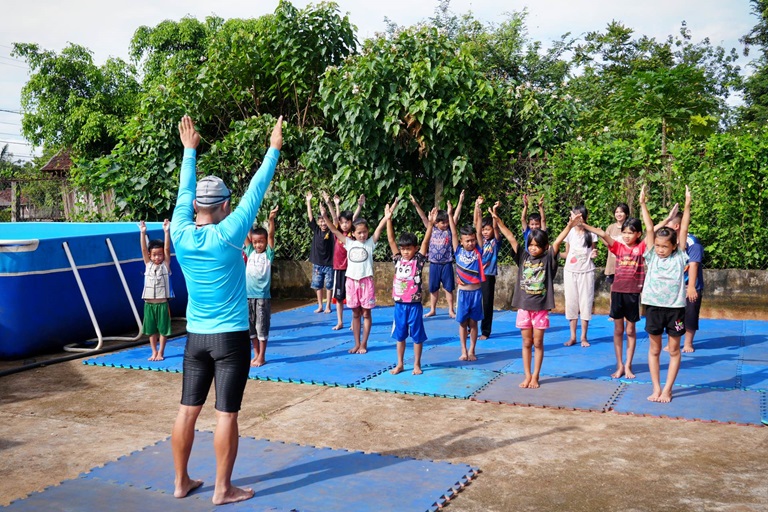SUNI-SEA Consortium, Global Alliance for Chronic Diseases (GACD)
Strengthening collaboration between healthcare providers and communities for hypertension and diabetes prevention and control in Vietnam
28 Aug 2024
WHO Regional Office for Western Pacific | 21 Dec 2023
Every drowning is preventable. Globally, however, hundreds of thousands of people lose their lives by drowning every year. In 2019, one in three of the world’s drowning deaths occurred in the World Health Organization’s (WHO) Western Pacific Region. Twenty per cent of these deaths were children under the age of 15. In Viet Nam, about 2,000 children drown every year.
For Mai Van Chuyen, a physical education teacher from Dak Lak province in Viet Nam, this statistic is all too real. “Between 2016-2021, more than 440 children drowned in our province,” he shares. “This is as big as an elementary school.”
The landscape in his district is peppered with lakes, dams and rivers, so Mr Chuyen knew something had to be done to prevent more children dying by drowning. He wanted to teach children how to swim, but he met some difficulties. “The community here experiences socioeconomic challenges,” he explains. “These remote places and villages lacked proper swimming pools for lessons and many children also faced financial barriers to travel to district centres for swimming lessons.”
So Mr Chuyen decided to bring swimming pools to the children. With support from communities and local authorities, he travels through the district on a tractor with a mobile swimming pool on a trailer behind. He sets up the pool in remote villages, fills it with water and teaches children how to swim. “I teach them basic underwater skills and safety, like breathing under water, moving around and playing games,” he says. “This makes learning fun and motivating.”

But preventing drowning in the area means getting the whole community on board. “My initial efforts were met with some resistance – parents couldn’t believe that I would teach for free.” Mr Chuyen visited families and held talks in each community, explaining why learning to swim is important and sharing information with parents about drowning prevention. “Equipping parents with knowledge to educate their children about water safety is important for reducing drowning incidents in the community,” he explains.
However, not all communities have someone like Mr Chuyen working to prevent drowning. According to the Regional Status Report on Drowning in the Western Pacific, drowning kills more children under the age of 15 in the Region than tuberculosis, HIV/AIDS, malnutrition, measles, meningitis, respiratory disease, hepatitis, dengue and malaria combined.
The 2021 report provides countries with WHO-recommended best practices on drowning prevention interventions and policies, including the use of barriers for controlling access to water, public awareness campaigns focused on behaviour change, and policies and legislation on water safety, including regulation of recreational boating and maritime transport.
WHO is working with countries around the Region to implement these best practices.
Between 2016 and 2020, more than 8.5 million school children learned water safety skills – and the number of childhood drownings decreased by 100 children per year. Viet Nam’s programme on child injury prevention and control aims to reduce drowning deaths among children by 10% between 2020 and 2025.
WHO, along with health partners Bloomberg Philanthropies and the Global Health Advocacy Incubator (GHAI), has been working with the Government of Viet Nam to develop technical and practical guidance on drowning prevention, build the capacity of provinces to run classes on swimming and water safety, and implement public awareness campaigns on child drowning prevention.
WHO Viet Nam Representative Dr Angela Pratt said, “Viet Nam has made very significant achievements in reducing deaths, but the rate of decrease has slowed in recent years – and we are still losing too many children.
“There is evidence from around the world about what works to reduce child drowning and save young lives. Viet Nam has invested in teaching water safety skills to children. We need to expand these good models of child drowning prevention like Mr Chuyen’s. They are low-cost interventions that can drastically reduce the risk of drowning and save children’s lives.
“We would also like to see more integration of child drowning prevention policies in relevant laws and policies, and more funding for child well-being, including drowning prevention initiatives.
“Finally, we need more communication to raise public awareness on preventing child drowning, and enhance the skills of both parents and children.”
There is still much work to be done to prevent deaths by drowning in the Region. Mr Chuyen has taught over 400 children to swim through his programme, but he hopes this small drop will become a wave to inspire greater change. “I hope that the students I've assisted will take meaningful actions and find roles that enable them to contribute to our community in the future as they grow. Perhaps, among them, there will be individuals who embark on and continue a similar journey to the one I am on.”